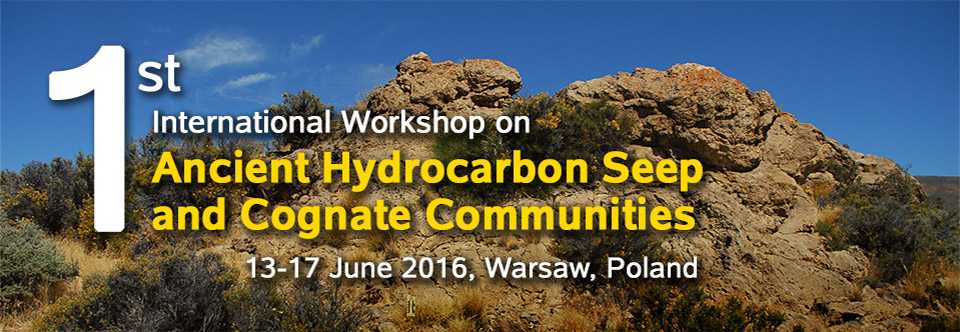
NON-DIMERELLOID BRACHIOPODS IN ANCIENT HYDROCARBON SEEPS
Maria Aleksandra BITNER1, Andrzej KAIM1, Robert JENKINS2, and Krzysztof HRYNIEWICZ1
1Institute of Paleobiology, Polish Academy of Sciences, ul. Twarda 51/55, 00-818 Warszawa, Poland; 2College
of Science and Engineering, Kanazawa University, Kanazawa 920-1192, Japan.
Corresponding author: bitner@twarda.pan.pl
Dimerelloids are the most common and characteristic brachiopods for ancient hydrocarbon seeps
and hydrothermal vents. They often occur in mass accumulations similar to these of chemosymbiotic
bivalves. Other brachiopods are much less common and in several instances they occur
seemingly fortuitously at hydrocarbon seeps. The best known association is reported from the
Campanian Omagari site in Japan where terebratulide Eucalathis occurs in significant quantities
and is apparently absent from ambient strata (Kaim et al. 2010). An exceptionally taxonomically
diverse brachiopod fauna occurs in the shallow water Late Jurassic–Early Cretaceous seeps in
Spitsbergen, comprising 16 species represented by one lingulide, three rhynchonellide and 12 terebratulide
species with the dominance of short-looped forms (Holmer and Nakrem 2012; Sandy et
al. 2014). A new locality from the Paleocene hydrocarbon seeps in Spitsbergen has one species of
short-looped terebratulide, belonging most probably to the genus Pliothyrina. Some new brachiopods
were also found in the Oligocene seeps in Japan. They are represented by a rhynchonellide
Frieleia sp. and terebratulide ?Terebratulina sp. There are no extant brachiopods that are unequivocally
associated with vent/seep environments, though some species are recorded in their vicinities
(e.g., Lee et al. 2008; Zezina 2008). Thus there is no evidence that they are obligatory members of
chemosynthesis−based communities, but are rather primary opportunistic colonisers of available
hard substrates (Lee et al. 2008).
References
Holmer, L.E. and Nakrem, H.A. 2012. The lingulid brachiopod Lingularia from the lowermost Cretaceous hydrocarbon seep bodies, Sassenfjorden area, central Spitsbergen, Svalbard. Norwegian Journal of Geology 92: 197–174.
Kaim, A., Bitner, M.A., Jenkins, R.G., and Hikida, Y. 2010. A monospecific assemblage of terebratulide brachiopods in the Upper Cretaceous seep deposits of Omagari, Hokkaido, Japan. Acta Palaeontologica Polonica 55: 73–84.
Lee, D.E., Gregory, M.R., Lüter, C., Zezina, O.N., Robinson, J.H., and Christie, D.M. 2008. Melvicalathis, a new brachiopod genus (Terebratulida: Chlidonophoridae) from deep sea volcanic substrates, and the biogeographic significance of the mid-ocean ridge system. Zootaxa 1866: 136–150.
Sandy, M., Hryniewicz, K., Hammer, Ø., Nakrem, H.A., and Little, C.T.S. 2014. Brachiopods from Late Jurassic–Early Cretaceous hydrocarbon seep deposits, central Spitsbergen, Svalbard. Zootaxa 3884: 501–532.
Zezina, O.N. 2008. Biogeography of the Recent brachiopods. Paleontological Journal 42: 830–858.
